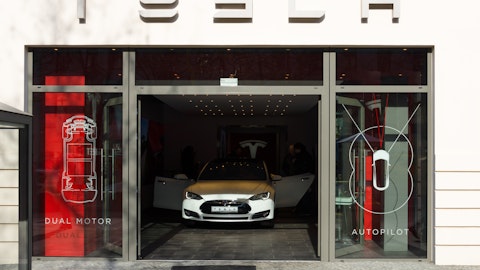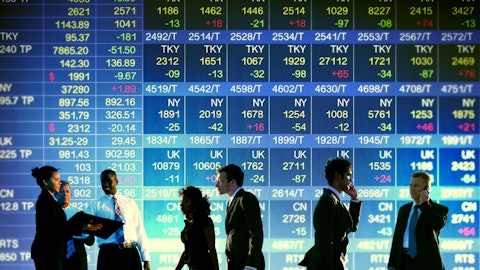Greenlight Capital recently released its Q1 2020 Investor Letter, a copy of which you can download below. The fund posted a return of -21.5% for the quarter, underperforming its benchmark, the S&P 500 Index which returned -19.60% in the same quarter. You should check out Greenlight Capital’s top 5 stock picks for investors to buy right now, which could be the biggest winners of the stock market crash. There weren’t a lot of funds who could deliver these kinds of returns without shorting the market or using aggressive put options.
In the said letter, Greenlight Capital highlighted a few stocks and Tesla Inc. (NASDAQ:TSLA) is one of them. Tesla is an electric vehicle and clean energy company based in California. Year-to-date, TSLA stock gained 93.6% and on May 15th it had a closing price of $799.17. Its market cap is of $150.2 billion. Here is what Greenlight Capital said:
“The TSLA melt-up from $418 at year end to a high of $969 on February 4 caused only a moderate loss, as much of our short position was structured in put spreads. Considering our continued negative view of the company, we did a good job maintaining a large exposure to our thesis working while avoiding a large loss in the parabolic move higher.
However, in the subsequent market decline, we would have expected to be rewarded in our TSLA puts. TSLA does not have a conservative balance sheet and has all kinds of exposure to the current crisis. Luxury car sales of all types are likely to collapse in a recession. We won’t know right away because TSLA’s plant is closed and the company can claim (without seeing the irony) that demand currently exceeds supply.
The closing of the factory is also inopportune because TSLA still enjoys a window in which its Model 3 and Model Y face limited global competition. The window is beginning to close, as TSLA has already lost a lot of share in Europe’s electric vehicle market. By next year, the U.S. market should become similarly competitive.
The first quarter (announced Wednesday) raised a host of new questions. For the last several quarters, TSLA has carried accounts receivable balances that are difficult to reconcile with its business model – where customers pay before taking delivery. TSLA has given multiple and contradictory explanations. The most recent version claimed that it takes a few days for payments to clear the banks and a little longer to arrive from Europe. TSLA also claims that because sales are crammed into the end of the quarter, it matters whether a quarter ends on a weekday. The first quarter ended on a Tuesday and unlike prior quarters, TSLA sales were not crammed into the last week of the quarter due to the pandemic. Had TSLA’s prior explanation been correct, days sales outstanding (DSO) should have plunged. Instead, they rose.5 The receivables remain a source of mystery. To the extent they exist, it is unlikely that they are explained by TSLA’s responses.
TSLA now produces in two factories, which has increased its overhead costs, while utilization rates are down significantly in Fremont. Despite an adverse product mix, the launch of the Model Y, shutdowns at its factories and currency headwinds, TSLA only had a modest decline in auto gross margin (excluding regulatory credit sales) for the quarter. Given the circumstances, this is hard to explain. Moreover, TSLA opened its factory in China while still somehow reporting reduced depreciation and SG&A expense sequentially. None of this makes sense to us and casts doubt on TSLA’s income statement.
TSLA is not a “growth” stock; rather it is a “story” stock. Even as TSLA furloughs its manufacturing workers, fires part of its salesforce, cuts everyone else’s salary, and renegotiates its rents with landlords, Elon Musk is days away from a nearly $1 billion option bonus6 due to TSLA sustaining an inflated stock price.
The TSLA “story” has resonated strongly with ESG investors. Relating to Governance, the insurance industry seems to get the joke. TSLA seemed unable to obtain D&O insurance on commercially reasonable terms. The Directors are now being insured by Musk. This creates an obvious conflict of interest that cripples the Directors’ ability to curtail Musk’s behavior – as he can now threaten that if the Board brought him down, the insurance may not have value. Making the Directors so beholden to Musk by definition makes them not independent.7
Musk’s overhyped response to the pandemic echoes his behavior in previous crises, and is little different from his fake promises to his customers. For example,8 for the last three years TSLA has sold a vaporware add-on called “full self-driving” for thousands of dollars. A year ago, Musk claimed that when the company’s software was “feature complete,” it could begin to enable TSLA cars to operate as autonomous “robotaxis” starting in mid-2020. On the fourth quarter of 2019 conference call, Musk admitted that “feature complete just means like it has some chance of going from your home to work let’s say with no intervention.”
However, with TSLA’s stock price on the edge of vesting Musk with a windfall, he recently used Twitter to double down on the “robotaxi in 2020” narrative.9
President Trump has called Musk a “genius” who “needs to be protected,” which is strange since TSLA is shifting its manufacturing to China. The President hasn’t seemed to mind… yet. This could be TSLA’s undoing, as its story increasingly depends on China for both cheaper manufacturing as well as consumer demand, against a backdrop of deteriorating relations between the two countries. TSLA shareholders are assuming enormous political risk in betting on the “TSLA in China” thesis.
Perhaps Musk’s flippant behavior around the pandemic – endangering his workforce and calling the government response “fascist” – will reveal his true nature to broader society and be reflected in the share price. Historically, stock promotions like this tend to unwind in economic down-cycles. TSLA advanced 25% in the first quarter and another 49% in April, bringing its year-to-date return to 87%.”
In Q4 2019, the number of bullish hedge fund positions on TSLA stock increased by about 59% from the previous quarter (see the chart here).
At Insider Monkey we leave no stone unturned when looking for the next great investment idea. For example, we believe electric vehicles and energy storage are set to become giant markets, and we want to take advantage of the declining lithium prices amid the COVID-19 pandemic. So we are checking out investment opportunities like this one. We read hedge fund investor letters and listen to stock pitches at hedge fund conferences. Our best call in 2020 was shorting the market when S&P 500 was trading at 3150 after realizing the coronavirus pandemic’s significance before most investors. You can subscribe to our free enewsletter below to receive our stories in your inbox:
Disclosure: None. This article is originally published at Insider Monkey.





